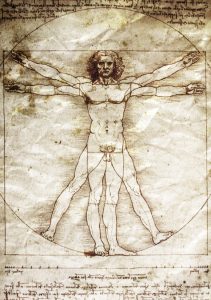Vitruvius was a Roman architect active in the first century BCE.
Life
Little is known about Vitruvius apart from what he says about himself in his writings. His praenomen is unknown, but a cognomen ‘Pollio’ was attested by M. Cetius Faventinus, a late-third or early-fourth century author on architecture.
It should be noted, though, that Faventinus’ statement is ambiguous in Latin (Vitruvius Pollio aliique auctores), and could be translated as either “Vitruvius Pollio and other authors” or “Vitruvius, Pollio, and other authors.”
He fought as an artilleryman under Caesar, for which he received a public pension. Octavia, sister of emperor Augustus, recommended that he continue receiving a pension so that he could continue to write. Conte notes that it is probably not a coincidence that Vitruvius’ work on architecture appears during the time Augustus was engaged in massive public works.
Works
Vitruvius’ only surviving work—and perhaps his only work—is the De Architectura in ten books. He begins, like many others in technical fields, by advocating for a liberal education (of the kind Cicero desired for orators in the De Oratore, or Quintilian in his Institutio Oratoria).
The rest of the book is outlined in a fairly straightforward manner.
- Book II touches upon the origins of architecture before discussing the types of material;
- Books III and IV discuss temples and other religious architecture;
- Books V concerns public areas, including baths, markets, harbors, and the theater;
- Books VI and VII are about the private sphere, with VII specifically on wall painting;
- Book VIII is on water types and aqueducts;
- Book IX deals with of math, sundials, and astronomy;
- Book X goes through the various machines useful for construction and crafting.
Unfortunately, all the diagrams that accompanied the De Architectura have been lost in the manuscript process.
Legacy

Vitruvius’ impact was strongest during the Renaissance when Europe was rediscovering the lost art of Roman architecture and engineering. Vitruvius’ discussion on the human body and proportionality led to Leonardo da Vinci’s (and others’) “Vitruvian Man,” the figure of which remains popular today.
Texts Online
Latin: PHI Latin Texts
